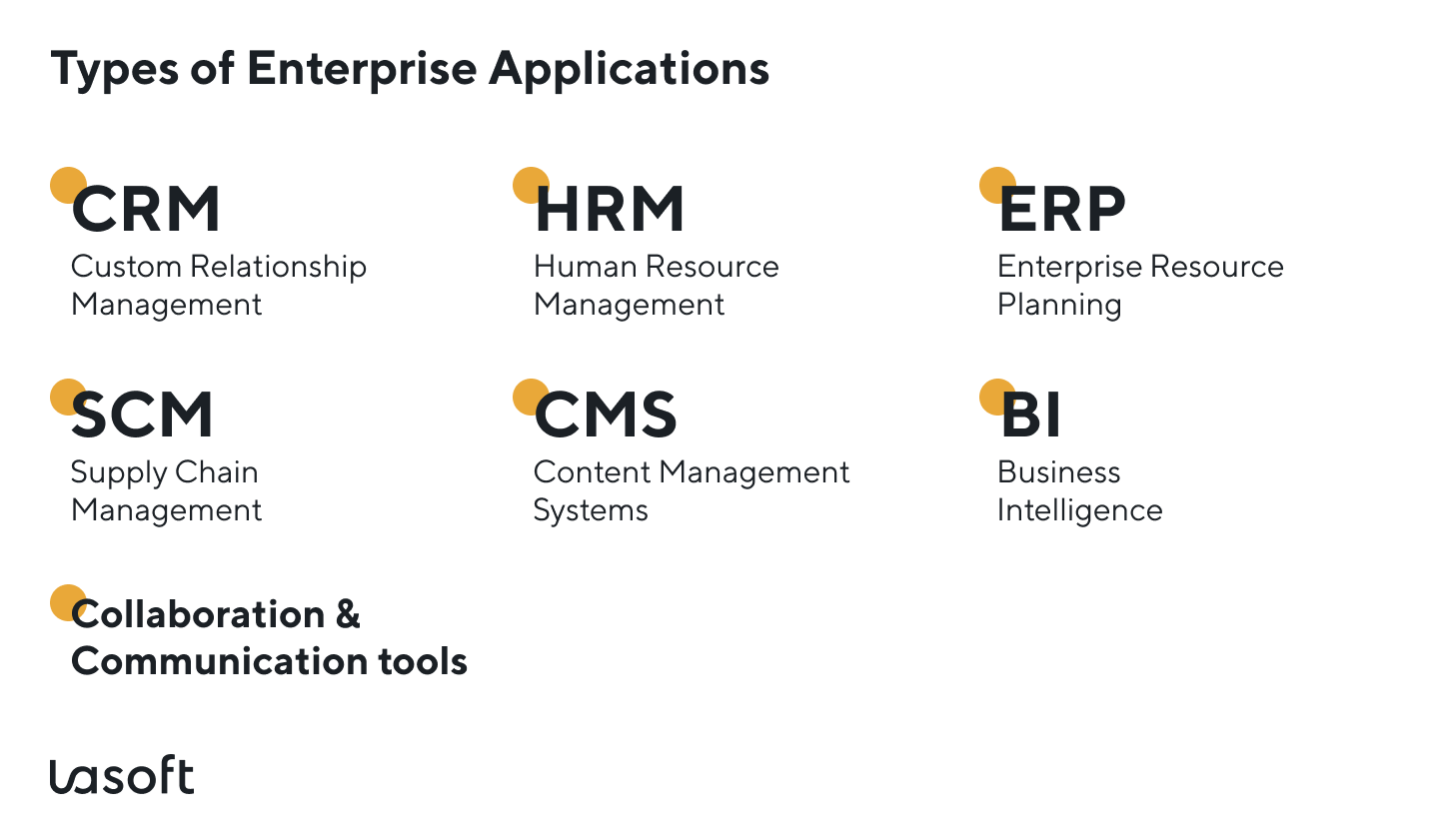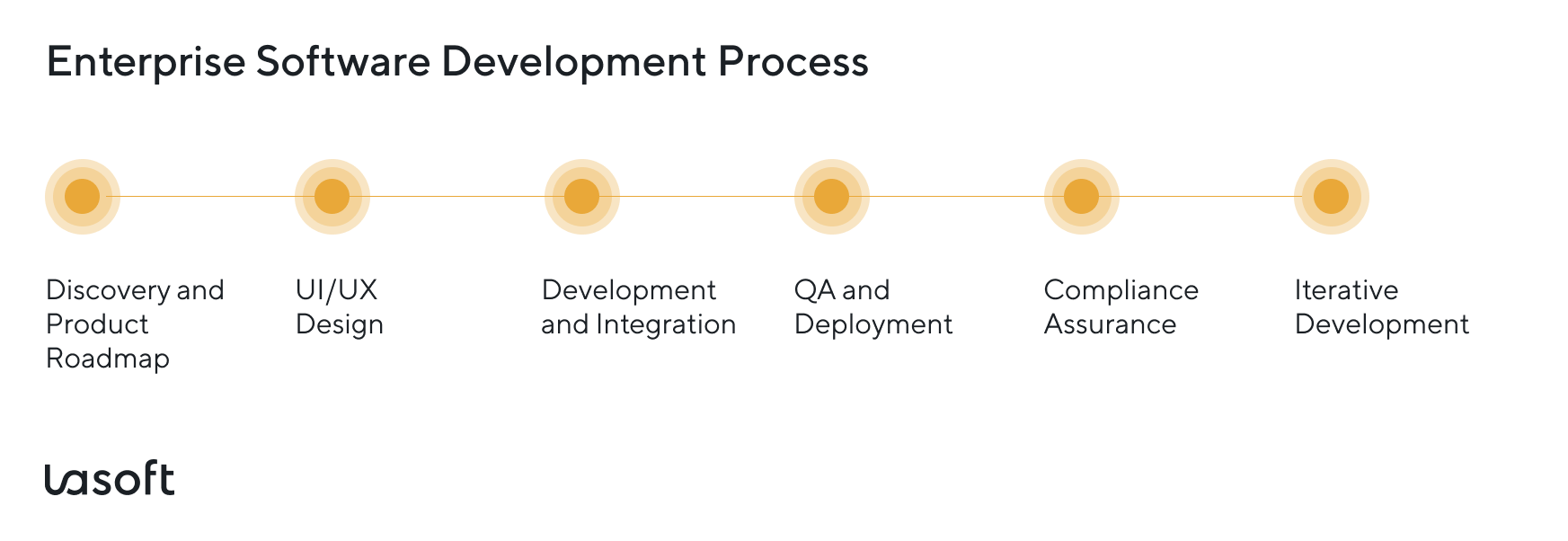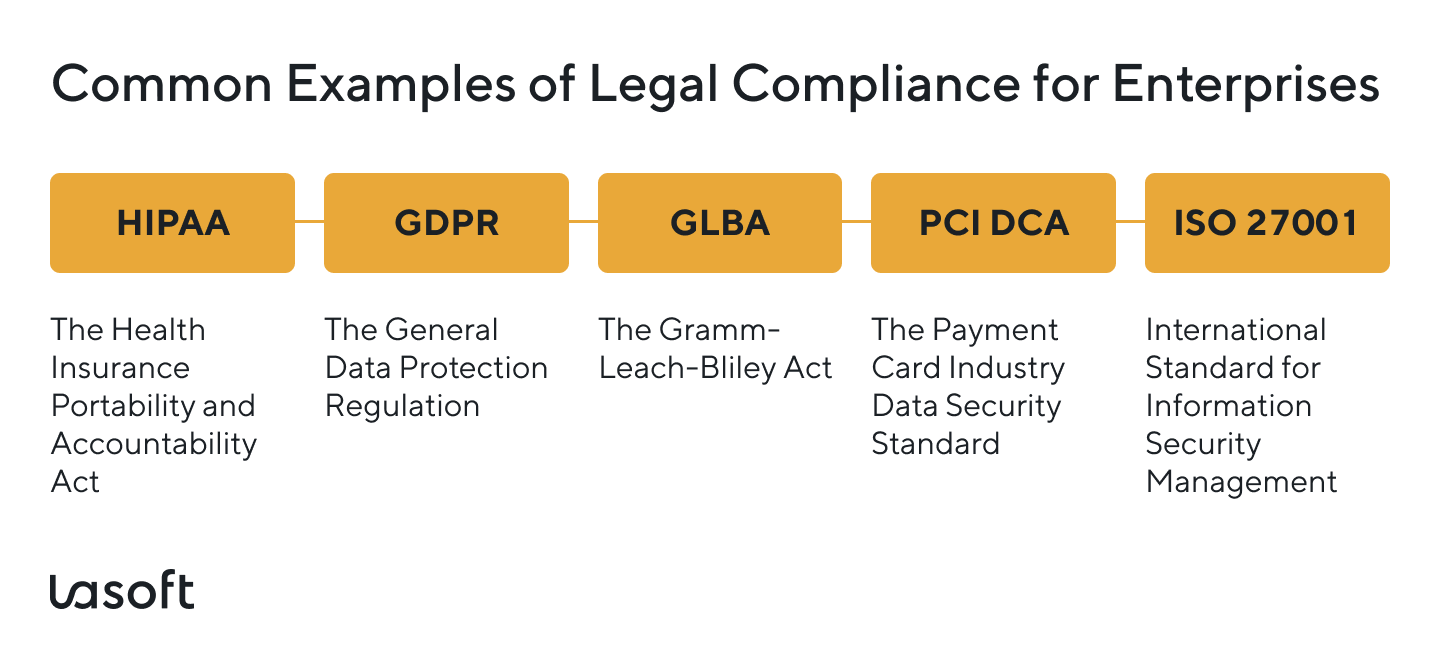You can find numerous software solutions that cater to the specific needs and address specific domains of various business models in the market. Still, enterprise solutions require solving multiple issues, transforming workflows across different departments to harmonize business processes, and creating software that enables continued innovation and scaling. This distinction demands specialized development teams with both technical expertise and business domain knowledge.
Quick Insight:
As digital transformation alters business processes, IT leaders are under pressure to automate outdated systems and drive operational efficiency. Enterprise software and AI-powered solutions are driving the shift, enabling businesses to stay competitive in the tech market. By 2033, the enterprise software market is expected to reach USD 22.6 billion, growing at a CAGR of 14.5% during the forecast period. (Source: businessresearchsights). It shows companies are willing to invest heavily in software tools that improve internal processes, connect teams, and support strategic decision-making.
What Exactly Is Enterprise Software Development?
Before we get to tools, architecture, or features, let’s answer the question: What’s different about enterprise software? Enterprise software refers to complex, scalable systems that manage a company’s internal operations and the workflows of various departments, including finance, HR, logistics, and customer relationship management. Unlike generic software, these can be customized to meet business goals and integrate with multiple legacy systems.
Enterprise software developers design solutions to support cross-functional collaboration, enabling businesses to remain agile in a rapidly changing market. Let’s break down why enterprise software development is unique, driving the digital economy, and how the right solution shows up across your business departments.
Cloud-Based vs. On-Premises Tools
Experts are reporting a shift in the software development market toward cloud-based development tools, driven by flexibility, cost, and ease of deployment. Clouds are ideal for companies seeking to work remotely and in an agile manner. A significant advantage is that cloud-native platforms also support continuous integration and delivery, enabling development cycles with constant updates.
On-premises tools will remain important for companies with stringent data security or compliance requirements, such as those in healthcare, finance, defense, and government. These organizations want to keep their infrastructure in-house so they have complete control over sensitive information.
Enterprises vs. SMEs Business Size
Large companies have multiple teams, complex workflows, and legacy systems that require transformation and automation. They need software development suites that integrate with their existing infrastructure and other platforms to manage large projects and teams across multiple departments effectively.
Smaller and medium-sized businesses (SMEs) look for tools that are simpler, quicker to set up, and easier to manage. They can choose low-code or no-code platforms, skip the heavy upfront investment in custom enterprise software development, and instead go for an off-the-shelf solution that meets some of their company’s needs.

Explaining Different Types of Enterprise Software Development
Enterprise software takes company workflows to the next level, automating repetitive tasks so teams spend less time on manual work and more time on value-adding strategic moves. Different types of enterprise software, such as ERP systems or collaboration tools, ensure that departments are aligned and communication is seamless, enabling efficient cross-functional collaboration.
Investing in enterprise systems is often the first meaningful step towards a broader digital transformation strategy. It sets the foundation for integrating advanced technologies like AI, machine learning, or IoT.
Different Types of Enterprise-Level Software Development
Enterprise software development focuses on company workflows to the next level, automating repetitive tasks so teams spend less time on manual work and more time on value-adding strategic moves. Different types of enterprise application software help companies to streamline operations, automating complex workflows. ERP, CRM systems, and custom AI-driven dashboards are all enterprise solutions that centralize data, automate repetitive tasks, and support a strategic view of market trends and internal workflows, enabling efficient cross-functional collaboration.
Investing in enterprise app development is often the first meaningful step towards a broader digital transformation strategy. It sets the foundation for integrating advanced technologies like AI, machine learning, or IoT.
| Customer relationship management (CRM) | CRMs enable companies to leverage digital strategies and technologies for managing and analyzing customer data and experience throughout the customer lifecycle, encompassing the interactions between the client and the product or service. CRM systems compile customer data across different channels, including the company’s website, telephone, live chat, e-mail campaigns, and social media. CRM features empower companies with marketing solutions, such as contact management, lead tracking, sales forecasting, and customer support management. |
| Enterprise resource planning (ERP) | Enterprise resource planning software integrates various business processes across departments, including HR, finance, and supply chain management. ERP helps manage and automate business tasks and operations, enhancing the efficiency of business activities and improving data accuracy. |
| Supply chain management (SCM) | This software optimizes the flow of goods and automates all processes that transform raw materials into final products. SCM covers everything from product development, sourcing, production, and logistics to the information systems needed to coordinate these activities. Managing inventory, tracking shipments, and streamlining communication, helping to collaborate with suppliers and partners. |
| Human resource management (HRM) | Human resource management (HRM) software offers a range of functionalities to provide efficient personnel management, including payroll processing, benefits administration, performance reviews, and hiring procedures. HRM guarantees compliance with labor rules and regulations while automating HR processes and providing optimal human resource management. |
| Business intelligence (BI) | BI tools enable the gathering, analysis, and visualization of data to gain insights into business processes. Features often include data integration, reporting, data visualization, and predictive analytics. The primary purpose of BI is to support management by providing insights derived from data. BI systems offer historical, current, and predictive views into business operations to make informed decisions, optimize processes, and gain competitive advantages. |
| Collaboration and communication tools | Project management tools, document-sharing platforms, and team communication tools foster seamless collaboration and communication among team members. They promote teamwork, improve productivity, and enhance information sharing. |
| Enterprise content management systems (CMS) | CMS applications help manage and publish digital content, including corporate websites and blogs. They provide web content creation, editing, and publishing tools. |

Essential Practices to Enhance Enterprise System Development
Effective enterprise system enhancement is about cross-functional input from business analysts, end-users, developers, and security teams. Collaboration ensures that improvements are grounded in real operational needs and align with broader business strategy.
| Big solutions for complex business processes | Enterprise software solves problems that can’t be solved with off-the-shelf tools. These systems involve deep process automation, multiple system integrations, custom workflows, and compliance layers that require advanced architecture and highly specialized development. |
| Continuous delivery | One of the best practices companies follow is the process of continuous delivery (CD). It’s when software engineers do IT audits, make updates, implement new features, and fix bugs. This minimizes downtime, enables faster value to market, and facilitates software updates that allow for quick evolution in response to user feedback or changing business needs. CD pipelines also support safer rollouts, automated testing, and more agile team operations. |
| Lasting vendor relationships | Enterprise software development typically involves long-term engagement with vendors and partners who support IT systems. These collaborations encompass not only software development but also support, digital transformation processes, and IT audits. |
| Strategic choice of software applications | Choosing the right platforms, infrastructure providers, and API ecosystems is essential. Enterprise software development teams often work closely with cloud providers (such as AWS, Azure, GCP), database vendors, and cybersecurity firms to ensure their software applications are secure. |
| Embrace AI and automation | Businesses that enhance regular software development with AI-powered solutions significantly boost efficiency for business operations. Cross-functional teams of ML engineers, data scientists, and full-stack developers build custom AI software, taking into account industry-specific and unique business challenges.
Companies recognize the business value in developing AI chatbots or virtual assistants to automate customer support and in-house communications with intelligent, NLP-powered bots, or to benefit from AI systems designed to forecast future trends (such as sales and churn), provide customer segmentation, and perform behavioral analytics. |
A successful enterprise development process is a clear, detailed plan of consistent stages that balance challenges with a long-term vision. The first stage is the discovery, which offers a product roadmap to align labor and technology investments with enterprise goals. Each stage of the software development life cycle adds value to the final product.
| 1. Discovery and product roadmap. | Every functional software solution that solves real-world users’ needs starts with understanding the problem. At this stage, Business analysts do market research, figuring out the answers to the following questions:
What’s the business trying to solve? – Product value for the market. What systems are already in place? – Competitors. Who will use the software? – The target audience. Deliverables at this stage may include:
|
| 2. UI/UX design | With a solid understanding of the product idea, the focus shifts to technical architecture and user experience (UX) design.
Any business system must strike a balance between usability and functionality, taking into account industry-specific requirements, business functions, and internal workflows for marketing campaigns, HR, data management, accounting software, and document management. Deliverables:
Meanwhile, UX/UI teams create rapid prototypes to visualize how users will interact with the system, enhancing customer engagement or improving workflows. The design needs to work for real people and real business processes. |
| 3. Development and integration | Software engineering teams proceed with building core features, often following Agile or DevOps methodologies to ensure transparency and flexibility. There’s a vast and vital part of the process that involves integrating new enterprise software with other tools the company already uses, such as ERPs, CRMs, HR platforms, or data warehouses.
This stage usually includes:
|
| 4. Quality assurance and deployment | In enterprise software development, releasing a product isn’t just about completing code—it’s about delivering a stable, secure, and reliable system that can perform under pressure. That’s where Quality Assurance (QA) and Deployment come into play. These final stages are crucial for turning a developed product into a trusted enterprise solution. Quality assurance is a process of testing functionality, performance, scalability, security, and compliance. QA teams simulate real-world usage to ensure that the software works as expected across various user roles, departments, and workflows.
Once the software product passes QA, it moves into the deployment stage.
|
| 5. Compliance assurance | Compliance assurance in enterprise software development means building software that consistently meets legal, regulatory, and security requirements. |
| 6. Iterative development | Software architecture and dev teams follow iterative development, often through Agile and DevOps practices. These efforts mean the software is developed in smaller, manageable sprints, improving each version of the product through feedback, testing, and market launch. Instead of waiting months to see results, teams get working features out quickly, gather input, and refine the product continuously.
One of the most valuable tools in this cycle is user testing, as their insights on functionality, usability, and whether the tool fits their workflow help shape the next sprint of improvements. Teams monitor user behavior, system performance, and error logs to spot bugs or inconsistencies. Ultimately, this approach makes enterprise solutions more adaptable and aligned with the needs of both the business and its users. |

Why Legal Compliance Matters for Enterprises
For large businesses, violating data protection or financial regulations is crucial, as it can result in multi-million-dollar fines or lawsuits. Beyond financial loss, failing to safeguard sensitive data can shatter customer trust and damage a brand’s reputation. In any case, customers and partners feel safer doing business with you if they know you take compliance seriously.
Different industries impose different rules on software systems. Here are a few widely recognized regulations and standards that development teams often need to address in enterprise projects:
| HIPAA | The Health Insurance Portability and Accountability Act is a U.S. healthcare law that requires the protection of patients medical records and personal health information. Healthcare software must include safeguards (like access controls and encryption) to ensure patient data stays confidential. |
| GDPR | The General Data Protection Regulation is a far-reaching data protection law from the EU, applying to any organization worldwide that handles EU residents’ personal data. GDPR grants individuals rights over their data (for example, requiring companies to obtain consent before using someone’s information) and imposes heavy fines for violations. |
| GLBA | The Gramm-Leach-Bliley Act is a U.S. law for the financial industry that mandates banks, lenders, and other financial institutions to explain how they share and protect customers’ private financial information. To comply with the GLBA, organizations must implement a written plan that outlines security features and safeguards to protect sensitive customer data. |
| PCI DSS | Payment Card Industry Data Security Standard is an industry-defined standard that all businesses handling payment cards (including credit and debit) must adhere to. PCI DSS sets technical requirements to secure cardholder data. Every online retailer, payment processor, or software handling credit card transactions is expected to comply with PCI DSS for the safety of customers’ financial data. |
| ISO 27001 | Enterprises should follow an international standard for information security management, or ISO 27001 certification, to prove they have a robust Information Security Management System (ISMS) in place. This standard requires companies to systematically assess risks, implement appropriate controls, provide data encryption, and continuously monitor and improve their data security processes. |
Future of Custom Enterprise Software Development
| AI voice assistants | To enhance customer support and streamline employee workflows, enterprises utilize AI solutions that enable users to interact with systems using their voice. Unlike text chatbots that rely on written text, voice assistants use natural speech to understand user commands, support speaking interaction with users, and perform tasks hands-free. Behind the scenes, AI voice assistants rely on Natural Language Processing (NLP) to interpret spoken language and extract meaning, and Machine learning (ML) algorithms learn from user behavior to offer increasingly personalized and context-aware responses.
Businesses use AI-driven voice interfaces in interactive voice response (IVR) systems, automating customer interactions, streamlining call routing, managing appointments, and offering customer services, all without requiring human support for basic tasks. AI voice assistants enhance efficiency while maintaining a human-like interaction. |
| Cloud services and edge computing | Enterprise software has shifted toward cloud-based platforms, meaning it’s designed to run in distributed environments. This means real-time collaboration, remote work, and dynamic scaling. Edge computing is primarily used in industries such as manufacturing, logistics, and healthcare, where data storage should be closer to the source to minimize latency and improve performance. |
| Security, compliance, sustainability | As enterprise systems become increasingly complex, cybersecurity and regulatory compliance will remain top priorities, driving the need for compliance automation, built-in privacy controls, and real-time threat detection. Additionally, sustainable IT practices, such as energy-efficient code and green hosting, will influence how enterprises build and deploy systems. |
Final Recap
Developing enterprise software systems requires technical skills and a deep understanding of business processes, regulatory environments, user behavior, and industry-specific challenges. That’s why choosing the right development partner and a reliable vendor who can offer strategic guidance is crucial for the success of your projects.
As a software development company, Lasoft understands that enterprise software projects are about solving real business challenges. Our teams bring together business analysts, UX/UI designers, AI specialists, and software engineers to build solutions that evolve with your company.
FAQ
What industries benefit most from the enterprise software development process?
How long does it take to develop an enterprise software development project?
Do I need to replace my legacy systems to implement new software?
Can LaSoft build AI-powered enterprise software projects?
How can an outsourcing team help with enterprise application development?
What is the discovery stage?
Our outbound discovery process involves proactively seeking information and collaborating with clients directly at their offices. This hands-on approach allows us to gain valuable insights from both external and internal sources, effectively shaping the direction of the software development project.
How to develop an enterprise app: tech expertise?
Our app development team of experienced developers crafts customized solutions using proven languages, frameworks, integrations, and infrastructure to bring your vision to life.
We offer expertise and skills to deliver exceptional solutions and results for end users. Companies may cut costs by eliminating specific roles within their teams. However, our experience has shown that omitting even one key role leads to significant losses and quality issues. The entire team becomes more efficient and productive when every role is filled.
What is a dedicated team at Lasoft?
Our applications are built with scalability in mind, ensuring that your software can grow in tandem with your business. This approach empowers our developers to seamlessly add new features and capabilities without disrupting your current operations, thereby maximizing the value of your investment.
Our UX/UI designers focus on creating intuitive and user-friendly interfaces. It enhances employee productivity and adoption by making the application easy to use and navigate.
We also use agile methodologies to ensure the development process is flexible and responsive to changes. Regular iterations and feedback loops keep the project on track and aligned with your goals. We integrate security measures into the architecture to protect your company data and ensure adherence to industry regulations, as well as meet your business needs.



